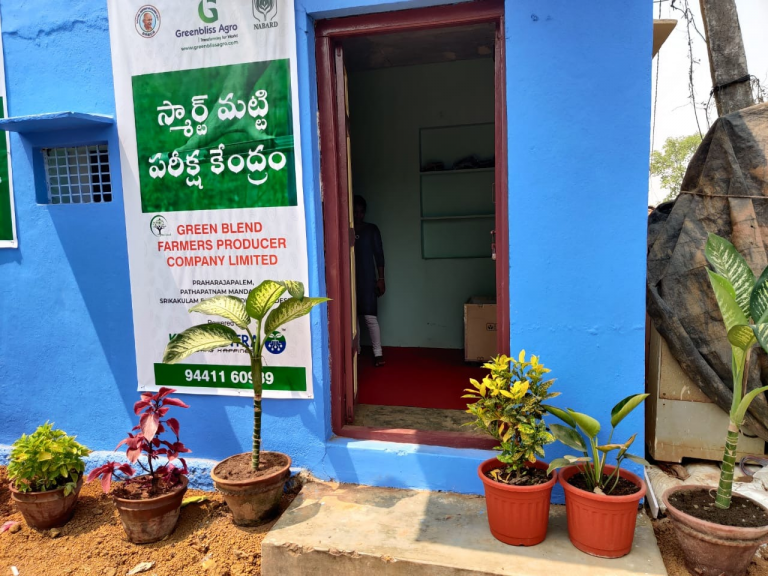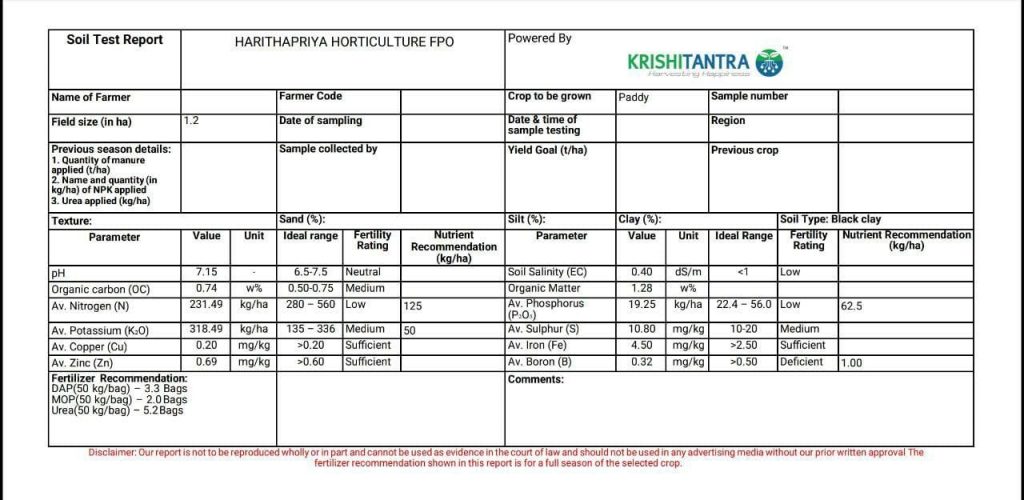Soil Health Management
“No Soil, No Food”
- Significance of Soil health management
Healthy soil is the foundation for profitable, productive, and environmentally sound agricultural systems. By understanding how the soil processes that support plant growth and regulate environmental quality are affected by management practices, it is possible to design a crop and soil management system that improves and maintains soil health over time.
Soil is a critical resource-the way in which it is managed can improve or degrade the quality of that resource. Soil is a complex ecosystem where living microorganisms and plant roots bind mineral particles and organic matter together into a dynamic structure that regulates water, air, and nutrients. In an agricultural context, soil health most often refers to the ability of the soil to sustain agricultural productivity and protect environmental resources. A healthy soil provides many functions that support plant growth, including nutrient cycling, biological control of plant pests, and regulation of water and air supply. These functions are influenced by the interrelated physical, chemical, and biological properties of soil, many of which are sensitive to soil management practices. Soils can be classified according to their pH value:
6.5 to 7.5—neutral
over 7.5—alkaline
less than 6.5—acidic, and soils with pH less than 5.5 are considered strongly acidic.
- Current scenario
The government has initiated the Soil Health Card scheme in February 2015 to enable the farmers to understand the soil health parameters and improve the productivity by judicious application of soil nutrients. This program is in running yet all the farmers are not able to get the soil reports in detail. Till date, only 60% (15,65,38,397) of the Soil Health Cards have been updated on the portal. This scheme has not reached the remote level. Farmers are not able to access and get the insights from the soil health cards in detail. This impacts on nonjudicial supply of nutrients results in deficiency and toxicity to the crop.
- Problems faced by stakeholders
Lack of awareness among the farmers about benefits of Soil Test based nutrients application and crop rotation
- Collection of soil samples in a scientific process need trained & skilled labour which is not available at village level
- The farmers are not in a position to get soil test reports in specified time and in detail
- They don’t have trust on the soil test reports provided by the government. STLs and not affordable even
- Farmers are not in a position to provide judicious use of fertilizers to the crops based on the reports
- Our Collaborations
In keeping view of the above problems faced by the stakeholders Greenbliss Agro has collaborated with KRISHITANTRA for the soil testing. The Product KRISHITANTRA is Rapid Automated Soil Test with Agronomy Advice is an automated soil analysis system that has been designed to provide results of soil nutrients with customized Agronomy.

- Smart Soil test centres
The soil testing helps to increase the crop yield and decrease usage of fertilizers. Our smart soil test centres uses the Artificial Intelligence AI and Internet of Things(IoT) to find the accurate deficiency of the soil parameters like pH, Organic carbon, Soil Salinity(EC), Nitrogen, Potassium, Copper, Zinc, Phosphorous, Sulphur, Iron, Boron. The soil testing report suggests the Recommended Dosage of Fertilizers like DAP, MOP, Urea to the field for the particular crop.





The Points going to address with KRISHITANTRA are as follows :
- EASE-OF-USE: Apart from soil sample preparation, the entire process is completely automated. It can be operated by anyone with basic school education and working knowledge of computers.
- ACCESSIBILITY: The device is portable and it can be made available at any location easily accessible to the farmers. It has been designed to work on electricity.
- TIME: This device provides results in less than 40 minutes, where the test results are stored on the cloud and delivered via SMS to the farmer.
- COST: The cost per test is much less than private labs and comparative to Govt. Labs
- ACCURACY:As the process is completely automated, there is little scope for human errors and simultaneous tests on the same device with the same soil sample have proved consistent.
- Objectives
The primary objectives of the Soil Health Management intervention are as follows:
- FPOs / FPCs and Farmers need to create awareness on the soil health management
- To make knowledgeable about how to collect the soil sample from crop land
- Providing training program on collection of soil samples in a scientific process at village level
- Will provide the detail reports about 11 parameters about the availability of micro and macro nutrients
- Collection of data from farmer
- Will help in fertilizer recommended dosages to enhance the soil health and improving productivity
- Sustainability check by our team
- Providing employment to the team
- Sustainability checks will be followed after 3 (three) months of application of appropriate amounts of fertilizer based on soil test analysis i.e. mapping those fields through geo fencing and taking satellite data
- This means that after recommending an appropriate dosage of fertilizer, one can find out how much the nutrient values in that soil have enhanced.
7. Impact
- The problematic soils will convert into healthier with the recommendations provided based on Soil test reports
- The Recommended use of fertilizers will results in good yield
- The cost of cultivation will reduces
- Specific soils treatment
The problematic soils are the soils whose productivity is lowered due to inherent unfavourable soil conditions. The problematic soils are namely saline, Sodic/alkaline and acidic soils. The problematic soils can be reclaimed by following cultural, Biological and chemical methods.
9.Soil Testing Team:
Village Level Entrepreneurs: Four VLE”s are appointed for each Smart soil test centre to interact with farmers and for collection of the soil.
Agronomist: One Agronomist for one soil test centre to test the soil.
- Sample of the Report:

- Key metrics
All the above discussed in one part and assessing and evaluating how the things are going is another important task. So, to do this on an online platform where everything is updated daily and also creating dashboards is very important
1)Training the FPO’s
2)Identifying the soil health centre in FPO’s
3)Identifying the 4 Village Level Entrepreneurs(VLE)
4)Establishing the soil test centre in collaboration with the krishitantra
5)Spreading the awareness about soil health centre
6)Understanding the types of crop and soil
7)Operator test the soil and the soil test is done in 40 minutes in the presence of the farmer
8)During this soil test a baseline survey is conducted about the farmer regarding the type of crop, the size of the farm, the cropping pattern
9)Based on the crop and the size of the farm recommended dosage of fertilizers(RDF) is given according to the soil test report
10)Establishing the input centres at the FPO
11)Making the inputs readily available for the farmer
12)Cross checking the RDF and implementation on RDF
13) Sustainability check will be followed after 3 (three) months of application of appropriate amounts of fertilizer based on soil test analysis i.e. mapping those fields through geo fencing and taking satellite data
14)Understanding the crop and based on that anticipating the demand
- Conclusion
Soil health is a concern worldwide and affects matters of food security, environmental protection and water quality. There have been many changes in agricultural management in recent decades, and while these have resulted in very positive soil health outcomes still there is a need to broaden the adoption of practices that protect and improve soil. Soil health and productivity are always going to be important in the farm business.

